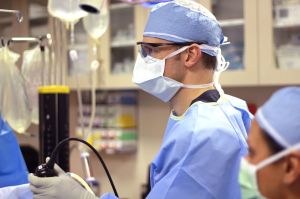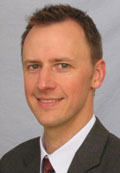ACL Injury Treatment Los Angeles
By Steven Meier
Injury to the anterior cruciate ligament (ACL) of the knee is common, particularly for athletes that require quick changes of direction and speed. While surgical reconstruction is often required to regain full function and withstand future athletic activity, recent advances have improved prognosis.
Arthroscopically-assisted ACL surgery – a minimally invasive outpatient procedure – leverages state-of-the-art technology to reconstruct the ACL with small incisions and minimal surgical trauma to the knee, meaning that patients can return to their jobs and favorite activities sooner, with less pain and fewer complications.
Steven W. Meier, M.D., Director of Meier Orthopedic Sports Medicine in Los Angeles, is an orthopedic surgeon who specializes in minimally invasive ACL reconstructive surgery – see below for more information. If you or someone you know has suffered an ACL injury, contact Dr. Meier in Los Angeles today at (310) 777-7845 to schedule a consultation.
Knee Anatomy
Three bones meet to form the knee joint: the femur (thighbone), tibia (shinbone), and patella (kneecap). Four ligaments – strong, fibrous tissues which connect these bones – provide structure and stability to the joint during weight-bearing movement:
- The anterior cruciate ligament (ACL) and posterior cruciate ligament (PCL) cross through the center of the joint, preventing the shinbone from sliding forward or backward against the thighbone, respectively.
- The medial collateral ligament (MCL) runs along the inside of the knee, preventing the joint from bending inward.
- The lateral collateral ligament (LCL) runs along the outside of the knee, preventing the joint from bending outward.
The ACL is the most frequently injured of the four, with between 100,000 to 200,000 tears in the US each year. A tear can be full or partial, occurring in the middle of the ligament or pulling the ligament off of the bone. About half of these injuries co-occur with damage to other knee structures – most commonly the MCL and meniscus (i.e., the “unhappy triad”).
Causes and Symptoms of an ACL Injury
 The ACL can be over-stretched (Grade 1 sprain), partially torn (Grade 2 sprain), or fully torn (Grade 3 sprain). ~70% of tears are noncontact injuries sustained from awkward landings, quick stops, or changes in direction. However, direct impact to the knee – e.g., a football tackle to a planted leg – can also cause a rupture. To this end, activities like basketball, football, soccer, and skiing are commonly linked to ACL injuries.
The ACL can be over-stretched (Grade 1 sprain), partially torn (Grade 2 sprain), or fully torn (Grade 3 sprain). ~70% of tears are noncontact injuries sustained from awkward landings, quick stops, or changes in direction. However, direct impact to the knee – e.g., a football tackle to a planted leg – can also cause a rupture. To this end, activities like basketball, football, soccer, and skiing are commonly linked to ACL injuries.
Typical symptoms of an ACL tear include hearing a “pop” in the joint, unexpected buckling of the knee, pain, swelling, loss of full range of motion, and discomfort while walking. Sometimes, patients describe the knee as momentarily slipping out of position. If you suspect that you have torn your ACL, do not continue the activity until you have seen an orthopedic specialist. Immediate aid should include elevation of the knee above the heart to reduce swelling, ice, and OTC pain medications (Aleve, Motrin, aspirin, Tylenol) as directed by the doctor. If the knee is unstable or there is pain, the use of a brace and crutches is advisable until seen by an orthopedic specialist.
Some patients with milder ACL tears may have fewer symptoms and remain unaware of the injury. It’s important to remember that the absence of classical symptoms does not rule out the presence of an ACL injury, and any instability in the knee or buckling of the joint are signs that a provider should be seen. A premature return to activity with an unknown ACL tear can lead to further, more serious knee damage.
ACL Injury Diagnosis
If you suspect that you have sprained or torn your ACL, it’s important to seek medical attention in a timely manner. The considerable swelling often associated with these injuries can make them difficult to diagnose, so delaying treatment isn’t wise. Although swelling, pain and range-of-motion may improve after a few weeks without treatment, do not continue the activity until you have seen an orthopedic specialist.
Physical Examination
A physical examination from an orthopedic specialist, combined with a detailed medical history, is usually sufficient to suspect a possible ACL injury. The timing of the injury and circumstance under which it happened, as well as the joint’s functional ability, stability, swelling, and pain, will all be taken into account.
The orthopedic specialist will typically test joint flexibility, strength, and stability, as well as ACL specific motions. For example, the Lachman Test – a common assessment used to diagnose an ACL injury – consists of pushing the thigh bone backward while pulling the shin bone forward in a slightly bent knee. An intact ACL prevents the shin bone from sliding forward, while a torn ACL will allow more give. This test, or an equivalent, may also be performed by an athletic trainer or medical provider at the time of the injury if one is present.
A physical examination should be done as soon as possible, as bleeding or swelling into the joint can render an injury more difficult to detect.
Imaging and Other Diagnostic Tools
To determine the exact severity of the injury and best treatment option, the orthopedic specialist often uses Magnetic Resonance Imaging (MRI) – a highly sensitive imaging tool for soft tissues such as ligaments, muscles, tendons, nerves, and blood vessels. Notably, MRI can also delineate concomitant knee injuries, such as a torn ACL, MCL, and meniscus, that all need attention. In certain cases, an x-ray can be used to rule out broken bones, and arthroscopy – a small camera inserted through a tiny incision in the knee, which allows the doctor to inspect the injury – may be used to aid in diagnosis.
ACL Injury Treatment
Non-surgical ACL Tear Treatment
A Grade 1 sprain – overextension of the ACL without tearing – as well as some partial tears, can be treated non-surgically with rest, bracing, and physical therapy. Icing, elevation, and OTC pain-relievers should be taken as directed by the doctor. After swelling has reduced, a doctor or physical therapist will guide the patient through proper exercises to improve strength and regain movement.
The orthopedic specialist may also recommend non-surgical treatment for older or less active patients, even if the ACL is torn. While a torn ACL will not heal on its own, proper physical therapy and bracing in these populations can return normal quality-of-life. Of course, there is a higher risk of subsequent knee injury without surgery, and those planning to return to high-level/high-risk physical activity will benefit from surgery.
For patients with partial or minimally displaced tears with moderate instability, there are ongoing investigations into using orthobiologics like platelet-rich plasma (PRP) and bone marrow-derived stem cells in bone marrow aspirate concentrate (BMAC) to stimulate healing of the ACL.
Arthroscopically-assisted ACL Reconstructive Surgery
For most ACL tears – especially for those who are young, have a physically demanding occupation, and wish to remain highly physically active – surgery may be necessary to restore knee stability. Fortunately, advances in surgical techniques have significantly improved the prognosis for return to high-level physical activity.
Specialists perform minimally invasive, arthroscopic surgery, requiring just two or three small incisions, each no longer than an eighth of an inch in diameter. By minimizing the damage done to the knee, arthroscopic surgery confers numerous benefits over traditional open surgery. With the former, patients have less pain and stiffness, fewer complications, and drastically reduced recovery times – key for active lifestyles and workplaces. Moreover, the smaller incisions lead to smaller surgical scars, and success rates are as good or better with arthroscopic surgery compared to traditional open surgery.
Summary of ACL Surgery Procedure
After anesthesia is given, the surgeon makes several small incisions to the knee through which a camera and surgical instruments are inserted to repair the joint. A saline solution is pumped into the joint, allowing more room to manipulate tools and better visualization of the procedure. First, the torn ACL is removed. Then, the surgeon will attach a replacement tissue – either from a donor or your own body – where the ACL used to be, restoring stability to the knee. Screws or other devices are used to hold the new structure in place. After the operation, dressings are placed over the incisions, and a wrap is placed around the knee joint.
- Length: 1-2 hours but can vary. Patients are able to go home the same day of surgery.
- Anesthesia: Most patients are sedated for the procedure, meaning you will be asleep and pain-free. Regional anesthesia to numb the leg may also be used.
- Potential Side Effects and Complications: Swelling and bruising immediately after procedure, resolved within weeks. As with any surgery, there is a risk of bleeding, infection, or stiffness in the joint. Potential risks should always be discussed with your doctor prior to any surgery, and most long-term complications can be avoided with proper rehabilitation.
- Recovery: Usually 6-8 weeks before returning to light physical activity. 4-6 months for more vigorous movement and up to 9-12 months for full-speed changes of direction (e.g., soccer, football, basketball, skiing).
Arthroscopic surgery is not restricted to ACL reconstruction or the knee, making it a versatile and comprehensive tool for joint repair. Other common arthroscopic knee surgery procedures include torn meniscus repair, torn cartilage repair, removal of loose bone or cartilage fragments, and damaged tissue repair or removal.
The Forefront of ACL Repair
Recently, there has been a renewed interest in the primary repair of ACL tears. Instead of replacing the damaged tissue with a graft, the native ligament itself is repaired with sutures through a less invasive procedure. Years ago, attempts at direct ligament repair were associated with lesser outcomes. However, with a better understanding of these injuries, improved repair techniques, and the new possibility of stimulating the healing response with orthobiologics like PRP and BMAC, there is hope for treating these injuries in carefully selected patients with a more anatomically-preserving approach. Theoretic advantages to primary repair of the native tissue include preserving the native blood vessels and nerve supply to better retain proprioception in the knee.
ACL Rehabilitation and Recovery
 Patients who have undergone arthroscopic surgery of the knee and complete a proper course of rehabilitation should have a normal and active lifestyle without serious discomfort.
Patients who have undergone arthroscopic surgery of the knee and complete a proper course of rehabilitation should have a normal and active lifestyle without serious discomfort.
There is no bed rest advised after the surgery. Research has shown that full extension and weight-bearing on the operated knee right after surgery – also known as accelerated rehabilitation – can safely prevent long-term loss of motion and strength while reducing pain. Of course, all steps taken in rehabilitation will be in accordance with the patient’s pain.
Your doctor or physical therapist will provide a series of exercises, first focusing on regaining full range of motion in the joint. Subsequent exercises will build strength surrounding the knee to protect the new ligament.
As with any rehabilitation program, patients should progress carefully and under close contact with a medical provider – a premature return to activity can reinjure the ACL or lengthen recovery time.
ACL Injury Treatment in Los Angeles
With beaches, mountains, and endless sunshine, Los Angeles is a hotbed for outdoor activity. Whether you’re hitting the slopes, surf, field, or gym, remember to stretch and warm-up properly before activity. Should an injury occur, seek the proper medical care as soon as possible.
Dr. Steven Meier is a renowned board-certified orthopedic surgeon specializing in regenerative sports medicine and arthroscopic surgery. He and his team in Los Angeles have helped countless patients recover from injuries to their ACLs. His extensive knowledge and experience in arthroscopic surgery make him one of the country’s foremost experts on the subject; he believes in treating each patient individually according to their needs.
Contact Dr. Meier and his team of experienced orthopedic surgeons in Los Angeles today at (310) 777-7845 to schedule a consultation at the Beverly Hills office.
Citations
1. Friedberg, R. P. (n.d.). Retrieved from https://www.uptodate.com/contents/anterior-cruciate-ligament-injury/contributors
2. Ma, B.C. (2019, April 21). ACL reconstruction. Retrieved from https://medlineplus.gov/ency/article/007208.htm
3. Ma, B.C. (2019, March 17). Knee arthroscopy. Retrieved from https://medlineplus.gov/ency/article/002972.htm
4. Ma, B.C. (2018, April 9). Anterior cruciate ligament (ACL) injury. Retrieved from https://medlineplus.gov/ency/article/001074.htm
5. Anterior Cruciate Ligament (ACL) Injuries (n.d.). Retrieved from https://orthoinfo.aaos.org/en/diseases–conditions/anterior-cruciate-ligament-acl-injuries/
6. Shelbourne K.D. and Nitz, P. (1990). Accelerated rehabilitation after anterior cruciate ligament reconstruction. Retrieved from http://journals.sagepub.com/doi/full/10.1177/036354659001800313?url_ver=Z39.88-2003&rfr_id=ori:rid:crossref.org&rfr_dat=cr_pub%3dpubmed
